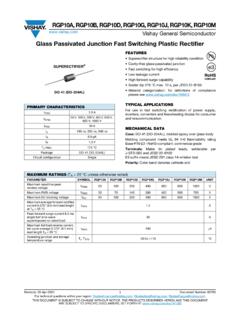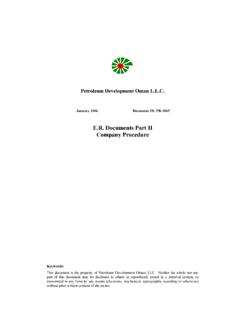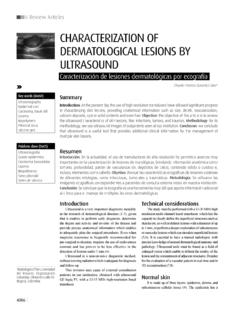Transcription of Structure, organization, and functions of cellulose ...
1 Braz. J. Plant Physiol., 19(1):1-13, 2007 REVIEWA nnually, plants produce about 180 billion tons of cellulose making it the largest reservoir of organic carbon on is a linear homopolymer of (1-4)-linked glucose residues. The coordinated synthesis of glucose chains isorchestrated by specific plasma membrane-bound cellulose synthase complexes (CelS). The CelS is postulated to becomposed of approximately 36 cellulose synthase (CESA) subunits. The CelS synthesizes 36 glucose chains in closeproximity before they are further organized into microfibrils that are further associated with other cell wall polymers. The36 glucose chains in a microfibril are stabilized by intra- and inter-hydrogen bonding which confer great stability onmicrofibrils.
2 Several elementary microfibrils come together to form macrofibrils. Many CESA isoforms appear to beinvolved in the cellulose biosynthetic process and at least three types of CESA isoforms appear to be necessary for thefunctional organization of CelS in higher words: cellulose biosynthesis, cellulose synthase (CESA), cellulose synthase complex (CelS), microfibrilEstrutura, organiza o e fun es dos complexos da sintase da celulose em plantas superiores: Anualmente, as plantasproduzem aproximadamente 180 bilh es de toneladas de celulose, sendo o maior reservat rio de carbono org nico noplaneta. A celulose um homopol mero linear composto por res duos de glicose unidos por meio de liga es (1-4).
3 As ntese coordenada das cadeias de glicose orquestrada por complexos espec ficos ligados membrana plasm tica(CelS). Postula-se que o CelS composto por aproximadamente 36 subunidades da sintase da celulose (CESA). CadaCelS sintetiza 36 cadeias de glicose dispostas lado a lado antes de serem organizadas em microfibrilas, que s o, poste-riormente, associadas com outros pol meros da parede celular. As 36 cadeias de glicose presentes em uma microfibrilas o estabilizadas por pontes de hidrog nio intra e inter-cadeias, conferindo grande estabilidade s microfibrilas. Asmicrofibrilas elementares s o dispostas lado a lado, permitindo a forma o das macrofibrilas.
4 V rias isoformas da CESA podem estar envolvidas no processo de bioss ntese de celulose e, no m nimo, tr s tipos de isoformas da CESA podemser necess rias para a organiza o funcional de cada CelS em plantas : bioss ntese de celulose, complexo da sintase da celulose (CelS), microfibrilas, sintase da celulose(CESA) structure , organization , and functions of cellulose synthasecomplexes in higher plantsReginaldo A. Festucci-Buselli1*, Wagner C. Otoni1 and Chandrashekhar P. Joshi21 Departamento de Biologia Vegetal, Laborat rio de Cultura de Tecidos, BIOAGRO, Universidade Federal de Vi osa,Vi osa 36570-000, MG, Brazil. 2 Biotechnology Research Center, School of Forest Resources and EnvironmentalScience, Michigan Technological University, Houghton, Michigan 49931, USA.
5 *Corresponding Phone: 55-31-3899-2930, Fax: 55-31-3899-2580 Received: 30 January 2007; Returned for revision: 26 April 2007; Accepted: 26 May 2007 INTRODUCTIONC ellulose is an outstanding commodity due to itsabundance and distinctive structural properties. Forexample, its tension resistance is comparable to that ofsteel (Eckardt, 2003). Even though cellulose has greatcommercial value for the pulp, paper, and textile as well aschemical industries which use it to produce commerciallyimportant polymers, cellulose biosynthesis in trees is stillnot well understood. Due to the economical significanceof tree cellulose for forest product industries, we have2 Braz.
6 J. Plant Physiol., 19(1):1-13, FESTUCCI-BUSELLI et our attention in this review on cellulosebiosynthesis in trees. Most of the recent findingsconcerning the molecular mechanism of cellulosebiosynthesis in higher plants resulted from research inmodel herbaceous plants and fiber crops and have beenreviewed recently (Somerville, 2006). cellulose is synthesized by cellulose synthaseenzymes (CESAs) and is regarded as a major sink foratmospheric carbon in plants because it is the maincomponent of the plant cell wall (Delmer and Haigler,2002). Many plant cell walls of commercial importance aremade up of three layers: middle lamellae, primary cell wall,and secondary cell wall.
7 The secondary cell wall is furthersubdivided into three sub-layers called S1, S2, and S3. Allthe layers present in the cell wall have two phases:microfibrilar and matrix (Brett and Waldron, 1990). Themicrofibrilar phase, a crystalline phase, is composed ofmicrofibrils of cellulose and the matrix phase, a non-crystalline phase, is composed of a variety ofpolysaccharides (pectins and hemicelluloses), proteins,and phenolic compounds (lignin, ferulic acid, coumaricacid, and others) (Brett and Waldron, 1990).There is a definite distinction between chemicalcomposition of the primary and secondary cell walls. Themost remarkable one is concerning the quantities ofcellulose and lignin.
8 The amount of lignin in secondarycell walls of trees like Populus trichocarpa (poplar) is 19-21%, whereas in the primary cell wall lignin is absent(Mellerowicz et al., 2001). The content of cellulose ,expressed in dry weight, in the primary cell wall of poplarsis 20-30%, whereas in the secondary cell wall it is 40-50%(Mellerowicz et al., 2001). For instance, some clones ofEucalyptus grandis cultivated in Brazil have a cellulosecontent of in the secondary cell wall (Gomideet al., 2005).In some special cases, when the developingangiosperm wood is under tension stress, a gelatinouslayer (G layer) is formed instead of the S2 or S3 layer(Timell, 1969; Mellerowicz et al.)
9 , 2001; Pilate et al., 2004).The G layer is composed almost exclusively of highlycrystalline axially oriented microfibrils of cellulose . Anincrease of 10-20% in the cellulose content and asignificant decrease in lignin content has been observedin tension wood in response to the deposition of the Glayer. Thus tension wood may represent an excellentsystem to study processes involved in cellulosebiosynthesis (Wu et al., 2000; Pilate et al., 2004). Forexample, in Populus tremuloides (aspen), thecoexpression of three CesAs, namely, PtrCesA1,PtrCesA2, and PtrCesA3, suggests that these threeCesAs may be important for the biosynthesis of highlycrystalline cellulose present in tension wood fibers(Bhandari et al.
10 , 2006). It has been reported thatKORRIGAN (KOR), a type of cellulase, is involved incellulose biosynthesis allowing proper formation ofmicrofibrils of cellulose I (Delmer and Haigler, 2002;Molhoj et al., 2002). The aspen Kor gene (PtrKor) hasbeen isolated and its expression pattern has beenanalyzed in aspen. Similar to three aspen CESAs, a highamount of PtrKOR protein was detected in developingxylem as well as on the upper side of the bent aspen stemin response to tension stress. In contrast, a very lowamount of PtrKOR protein was detected on the oppositeside of the bent stem experiencing compression stress(Bhandari et al.












